February 10, 2015
Marketing Automation Statistics
Since industry stats and trusted figures can be hard to come by, we’ve compiled this list of 30 statistics (and their sources) that will help give an overview of the current trends in the marketing automation industry. Read on to learn key data points on adoption, effectiveness, trends, and challenges of using marketing automation software.
Who’s Using Marketing Automation Software?
1. Only about 4% of US businesses with 20 or more employees are users of marketing automation software. Source: VentureBeat, “Buyers and Users Marketing Automation Survey: Results, Analysis and Key Findings” (2014) 2. Labeled a “hot” sector after an initial wave of consolidation in 2012-2013, marketing automation is still in its early stages as evidenced by penetration at less than 10% among the SMB and micro segments. 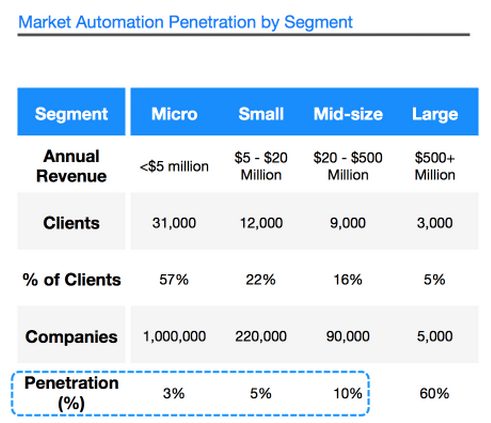 Source: Digital Capital Advisors, “Marketing Technology Sector Update: Marketing Automation” (2015) 3. More than 60% of marketers use mass email blasts to stay in touch with customers, however only 13% are using marketing automation software. Source: Autopilot, “Marketing Automation Performance Report” (2015) 4. Only 22% of companies are using marketing automation software today, trailing far behind more mainstream channels like social media or the corporate website. Source: Salesforce, “State of Marketing” (2015) 5. 56% of companies use an email marketing provider. This is a significant factor since firms that use email marketing are 75% or more likely to be purchasers of MAS over the next year.
Source: Digital Capital Advisors, “Marketing Technology Sector Update: Marketing Automation” (2015) 3. More than 60% of marketers use mass email blasts to stay in touch with customers, however only 13% are using marketing automation software. Source: Autopilot, “Marketing Automation Performance Report” (2015) 4. Only 22% of companies are using marketing automation software today, trailing far behind more mainstream channels like social media or the corporate website. Source: Salesforce, “State of Marketing” (2015) 5. 56% of companies use an email marketing provider. This is a significant factor since firms that use email marketing are 75% or more likely to be purchasers of MAS over the next year. 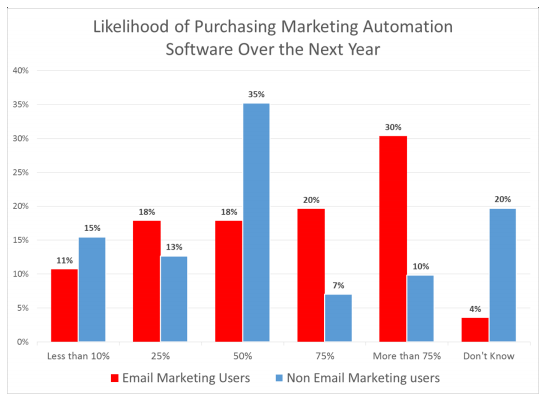 Source: VentureBeat, “Buyers and Users Marketing Automation Survey: Results, Analysis and Key Findings” (2014) 6. Best-in-class companies are 67% more likely to use a marketing automation platform. Source: Aberdeen Group, “State of Marketing Automation 2014: Processes that Produce” (2014) 7. 79% of top-performing companies have been using marketing automation for more than 2 years.
Source: VentureBeat, “Buyers and Users Marketing Automation Survey: Results, Analysis and Key Findings” (2014) 6. Best-in-class companies are 67% more likely to use a marketing automation platform. Source: Aberdeen Group, “State of Marketing Automation 2014: Processes that Produce” (2014) 7. 79% of top-performing companies have been using marketing automation for more than 2 years. 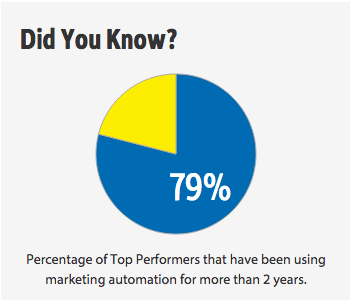 Source: Gleanster, “Q3 Marketing Automation Benchmark” (2013) 8. 91% of buyers in 2013 were evaluating marketing automation for the first time. Source: Software Advice, “Marketing Automation Software BuyerView” (2014) 9. Marketing automation will be amongst the most piloted marketing technologies of 2015. Source: Salesforce, “State of Marketing” (2015) **The Bottom Line: **Several studies show there is currently low adoption of marketing automation software overall with top performing and best-in-class companies earlier to the market. However, there is a high percentage of email software users, the majority of which are likely to graduate to marketing automation this year.
Source: Gleanster, “Q3 Marketing Automation Benchmark” (2013) 8. 91% of buyers in 2013 were evaluating marketing automation for the first time. Source: Software Advice, “Marketing Automation Software BuyerView” (2014) 9. Marketing automation will be amongst the most piloted marketing technologies of 2015. Source: Salesforce, “State of Marketing” (2015) **The Bottom Line: **Several studies show there is currently low adoption of marketing automation software overall with top performing and best-in-class companies earlier to the market. However, there is a high percentage of email software users, the majority of which are likely to graduate to marketing automation this year.
Is Marketing Automation the Key to Success?
10. 67% of marketing automation-users listed the technology as “very effective/effective.” Source: Salesforce, “State of Marketing” (2015) 11. Marketers that have adopted marketing automation technology say the main benefits are:
- Taking repetitive tasks out of marketers hands, allowing focus on new/more exciting projects (36%)
- Better targeting of customers and prospects (30%)
- Improving the customer experience (10%)
- Better email marketing (9%)
- Reduction of human error in campaigns (8%)
- Lead management (4%)
- Multichannel marketing (3%)
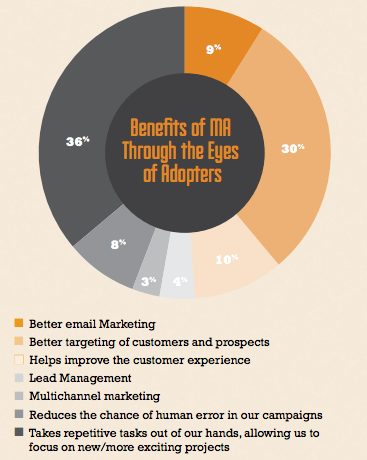 Source: Redeye and TFM&A Insights, “The Marketing Automation Report” (2014) 12. While companies using blast email software still generate more leads than those who use nothing at all, marketers using automation software generate 2X the number of leads than those using blast email software and are perceived by their peers to be 2X as effective at communicating.
Source: Redeye and TFM&A Insights, “The Marketing Automation Report” (2014) 12. While companies using blast email software still generate more leads than those who use nothing at all, marketers using automation software generate 2X the number of leads than those using blast email software and are perceived by their peers to be 2X as effective at communicating.  Source: Autopilot, “Marketing Automation Performance Report” (2015) 13. Companies that use marketing automation are 3x more likely than companies without automation to track and attribute their content-marketing efforts to multiple touchpoints (36% to 11%). Source: The Lenskold Group, “Lead Generation and Marketing Effectiveness Survey” (2013) 14. Companies using marketing automation see 53% higher conversion rates from initial response-to-MQL and a revenue growth rate that is 3.1% higher than non-users. Source: Aberdeen Group, “Marketing Lead Management Report” (2012) 15. 28% of marketing teams using marketing automation reported an increase in the average deal size from a marketing qualified lead that was passed to sales; the credit goes to the stronger relationship resulting from nurturing and educating buyers.
Source: Autopilot, “Marketing Automation Performance Report” (2015) 13. Companies that use marketing automation are 3x more likely than companies without automation to track and attribute their content-marketing efforts to multiple touchpoints (36% to 11%). Source: The Lenskold Group, “Lead Generation and Marketing Effectiveness Survey” (2013) 14. Companies using marketing automation see 53% higher conversion rates from initial response-to-MQL and a revenue growth rate that is 3.1% higher than non-users. Source: Aberdeen Group, “Marketing Lead Management Report” (2012) 15. 28% of marketing teams using marketing automation reported an increase in the average deal size from a marketing qualified lead that was passed to sales; the credit goes to the stronger relationship resulting from nurturing and educating buyers.  Source: Lenskold, “Lead Generation Marketing Effectiveness Study” (2012) The Bottom Line: While a low percentage of users have adopted the software, the stats show that usage can significantly improve marketing performance by allowing marketers to be more strategic with their communication touch points with their contacts.
Source: Lenskold, “Lead Generation Marketing Effectiveness Study” (2012) The Bottom Line: While a low percentage of users have adopted the software, the stats show that usage can significantly improve marketing performance by allowing marketers to be more strategic with their communication touch points with their contacts.
**The Case for Personalization, Nurturing Relationships & Multi-Channel Approaches **
16. 86% of senior-level marketers say that it’s absolutely critical or very important to create a cohesive customer journey. Source: Salesforce, “State of Marketing” (2015) 17. 86% of shoppers who have experienced personalization believe it influences what they purchase to some extent. Source: Digital Capital Advisors, “Marketing Technology Sector Update: Marketing Automation” (2015) 18. Personalized emails improve click-through rates by 14%, and conversion rates by 10%. Source: Aberdeen Group, “B2B Social Media Marketing: Are We There Yet?” (2012) 19. Relevant emails drive 18x more revenue than broadcast emails. Source: Jupiter Research, “The ROI of Email Relevance: Improving Campaign Results Through Targeting” (2005) 20. 60% of people are highly likely to make a purchase based on offline word-of-mouth.  Source: Digital Capital Advisors, “Marketing Technology Sector Update: Marketing Automation” (2015) 21. Up to 50% of leads aren’t ready to buy when they first inquire about your business, but 75% of those leads will become sales ready within 12 to 18 months. Source: Gleanster, “Measuring the Impact of Lead Nurturing on the Sales Pipeline” (2010) 22. Companies that excel in lead nurturing generate 50% more sales-ready leads at 33% lower cost per lead. Source: Forrester Research 23. Companies that nurture their leads get 45% more lead generation ROI than companies that do not. Source: MarketingSherpa, “B2B Marketing Benchmark Report” (2012) 24. Nurtured leads make purchases that are 47% larger, on average, than non-nurtured leads. Source: Annuitas (2011) 25. Roughly 15-20% of non sales-ready leads eventually purchased after lead nurturing. Source: Gleanster, “Measuring the Impact of Lead Nurturing on the Sales Pipeline” (2010) 26. Marketers who segment their lists and employ quality targeting can improve conversion by 355% and increase revenues by 781%. Source: Jupiter Research (2011) **The Bottom Line: **Personalization, lead nurturing and multi-channel marketing are trending. Implementing marketing automation can help you provide a seamless buyer experience from first touch to happy customer.
Source: Digital Capital Advisors, “Marketing Technology Sector Update: Marketing Automation” (2015) 21. Up to 50% of leads aren’t ready to buy when they first inquire about your business, but 75% of those leads will become sales ready within 12 to 18 months. Source: Gleanster, “Measuring the Impact of Lead Nurturing on the Sales Pipeline” (2010) 22. Companies that excel in lead nurturing generate 50% more sales-ready leads at 33% lower cost per lead. Source: Forrester Research 23. Companies that nurture their leads get 45% more lead generation ROI than companies that do not. Source: MarketingSherpa, “B2B Marketing Benchmark Report” (2012) 24. Nurtured leads make purchases that are 47% larger, on average, than non-nurtured leads. Source: Annuitas (2011) 25. Roughly 15-20% of non sales-ready leads eventually purchased after lead nurturing. Source: Gleanster, “Measuring the Impact of Lead Nurturing on the Sales Pipeline” (2010) 26. Marketers who segment their lists and employ quality targeting can improve conversion by 355% and increase revenues by 781%. Source: Jupiter Research (2011) **The Bottom Line: **Personalization, lead nurturing and multi-channel marketing are trending. Implementing marketing automation can help you provide a seamless buyer experience from first touch to happy customer.
So why aren’t marketing automation users happy?
27. 44% of marketers are not fully satisfied with their marketing automation systems, the top 3 reasons being that the software takes too long to implement, is difficult to learn and is expensive. Source: Autopilot, “Marketing Automation Performance Report” (2015) 28. 38% of marketing automation users were actively considering switching marketing automation systems in the coming year. Source: VentureBeat, “Buyers and Users Marketing Automation Survey: Results, Analysis and Key Findings” (2014) 29. The top concerns about implementing the new marketing automation technology are budget constraints, siloed organizations, and poor data quality. Nearly one in four respondents found marketing automation systems too complex to be used effectively. 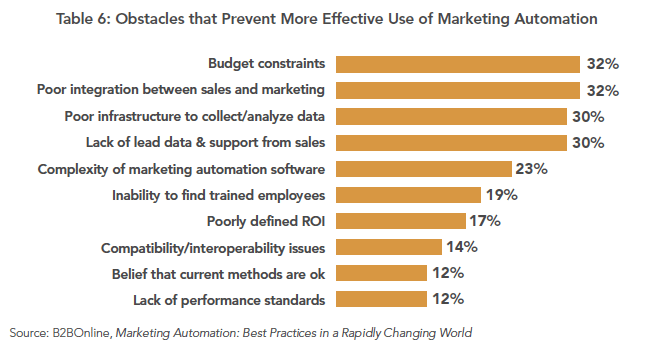 Source: B2BOnline, “Marketing Automation: Best Practices in a Rapidly Changing World” 30. “Very low cost” (46%) and ease of use (39%) are the top criteria that would encourage non-users of marketing automation to consider implementing the technology, followed by access to analytics and insights capabilities.
Source: B2BOnline, “Marketing Automation: Best Practices in a Rapidly Changing World” 30. “Very low cost” (46%) and ease of use (39%) are the top criteria that would encourage non-users of marketing automation to consider implementing the technology, followed by access to analytics and insights capabilities. 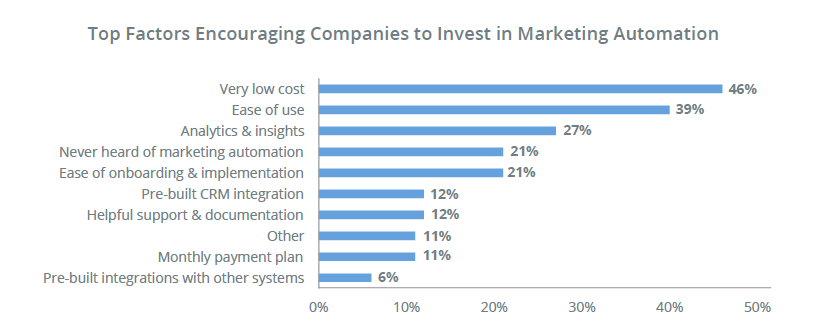 Source: Autopilot, “Marketing Automation Performance Report” (2015) The Bottom Line: The potential for marketing automation success is there, but it is currently not very accessible to small to mid-sized business who do not have the staff, resources, budget or time to implement and utilize the software effectively. Do you know of any other surprising marketing automation statistics out there? Please share with us in the comments.
Source: Autopilot, “Marketing Automation Performance Report” (2015) The Bottom Line: The potential for marketing automation success is there, but it is currently not very accessible to small to mid-sized business who do not have the staff, resources, budget or time to implement and utilize the software effectively. Do you know of any other surprising marketing automation statistics out there? Please share with us in the comments.













